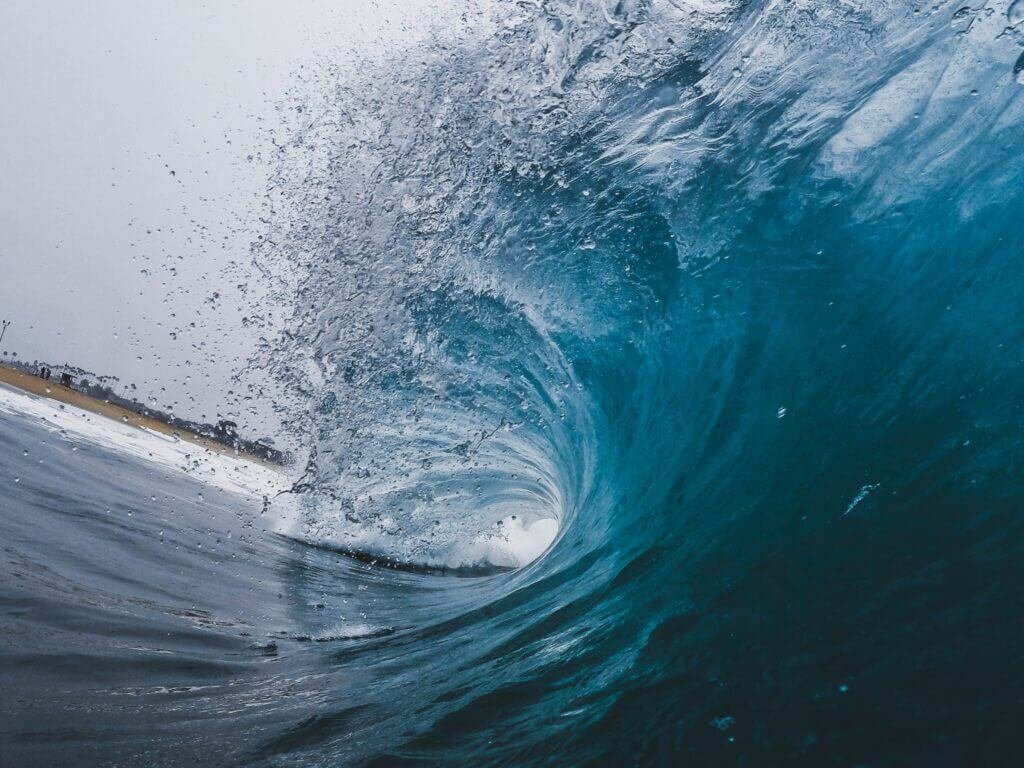Surf slang is a unique vocabulary used by surfers to describe the sport, the waves, and the culture. Surf slang can be used to describe all aspects of the sport, from the waves themselves to the surfers who ride them. It is a way for surfers to communicate with each other and share their passion for the sport.
Surf slang started to develop in the early 20th century, as surfing became more popular in Hawaii and California. Surfers began to create their own unique vocabulary to describe the waves, the sport, and the culture.
One of the earliest influences on surf slang was the Hawaiian language. Many Hawaiian words, such as “aloha,” “mahalo,” and “wahine,” are still used by surfers today. Other early influences included the beach culture of Southern California and the rise of surfing films and TV shows in the 1950s and 1960s.
Over the years, surf slang has continued to evolve, reflecting new trends in the sport and popular culture. For example, the term “kook,” which was originally used to describe a beginner surfer, is now sometimes used to describe any surfer who is considered to be lacking in skill or etiquette.
Here are some examples of how surf slang has evolved over time:
- 1960s: “Radical,” “groovy,” “tubular”
- 1970s: “Cowabunga,” “gnarly,” “hang loose”
- 1980s: “No problemo,” “dude,” “righteous”
- 1990s: “Sick,” “awesome,” “insane”
- 2000s: “Epic,” “stoked,” “chilled”
- 2010s: “Yewww,” “narly,” “booyah”
Today, surf slang is a global phenomenon, with surfers from all over the world using the same terms to communicate with each other. It is a way for surfers to connect with their shared passion for the sport and to express their unique culture.
Surf slang is a constantly evolving language, and new terms are being added all the time. It is a way for surfers to express their passion for the sport and to connect with their shared culture.
Some surf slang has become mainstream and known outside of the surfing community. Some examples include:
“Hang loose” – A friendly greeting or gesture that is often used by surfers and non-surfers alike.
“Shaka” – A Hawaiian greeting gesture that is also used by surfers and non-surfers.
“Gnarly” – A term used to describe challenging or difficult waves or conditions.
“Stoke” – A term used to describe excitement or happiness.
“Rad” – A term used to describe something that is cool or awesome.
These terms have become part of popular culture through surfing movies, TV shows, and music. They are now used by people all over the world, regardless of whether they surf or not.
Surfers come up with slang in a variety of ways. Some terms are simply descriptive, such as “barrel” or “cutback.” Others are more creative and humorous, such as “kook” or “gnarly.” Still others are borrowed from other languages or cultures, such as “shaka” from Hawaiian.
Once a new term is coined, it spreads to other surfers through word-of-mouth, social media, and surfing magazines and videos. Surfers from different parts of the world often collaborate with each other, which helps to spread new slang terms globally.
Here are some examples of how surf slang has spread around the world:
- In the 1960s, Australian surfers began using the term “grommet” to describe young surfers. This term quickly spread to other surfing communities around the world.
- In the 1970s, Hawaiian surfer Eddie Aikau popularized the shaka hand gesture. This gesture is now used by surfers all over the world as a friendly greeting.
- In the 1980s, American surfer Tom Curren helped to popularize the term “stoke.” This term is now used by surfers all over the world to describe excitement or happiness.
- In the 1990s, the rise of surfing movies and TV shows helped to spread surf slang to a wider audience. Movies such as “Point Break” and “North Shore” introduced millions of people to surf slang terms such as “tube,” “drop-in,” and “wipeout.”
Today, social media plays a major role in the spread of surf slang. Surfers from all over the world can connect with each other and share new slang terms through Instagram, Twitter, and other platforms.
Surf slang is a unique and dynamic language that is constantly evolving. It is a way for surfers to express their passion for the sport and to connect with their shared culture.
It is not bad to ask a surfer what they mean when they say a word that you do not know what it means. In fact, surfers are usually happy to explain their slang to non-surfers. They want to share their love of the sport with everyone, and that includes teaching people about their unique culture.
If you are ever unsure about the meaning of a surf slang term, do not hesitate to ask. Surfers are typically friendly and approachable people. They will be happy to explain the term to you and help you learn more about the sport.
Here are some tips for asking a surfer what a word means:
- Be polite and respectful.
- Let them know that you are interested in learning more about surfing and their culture.
- Be specific about the word or phrase that you do not understand.
- Be patient and understanding. Surfers may use slang terms that are specific to their region or surfing spot.
Here is an example of how you could ask a surfer what a word means:
“Hey, I’m new to surfing and I was wondering what the word ‘gnarly’ means.”
The surfer is likely to be happy to explain the term to you and give you some examples of how it is used.
So, don’t be afraid to ask a surfer what a word means. They are usually happy to help!
Surfers do sometimes go around thinking of new words to describe surfing. This is because surfing is a complex and dynamic sport, and there are many different aspects of it that need to be described. Surfers want to have a language that is specific and accurate, so they often come up with new terms to fill in the gaps.
Some surfers also enjoy the creativity of coming up with new slang terms. It is a way for them to express their individuality and to connect with other surfers who share their passion for the sport.
Surf slang terms can be descriptive, humorous, or even nonsensical. Some examples of surf slang terms that have been coined in recent years include:
- “Yew!” – An exclamation of excitement or satisfaction.
- “Narley!” – A term used to describe something that is gnarly or challenging.
- “Booyah!” – A term used to express excitement or victory.
- “Shredding the gnar!” – A term used to describe surfing very well in challenging conditions.
- “Getting pitted!” – A term used to describe surfing a barrel wave.
These terms are often used in surfing videos, magazines, and on social media. They are also starting to be used by non-surfers, as surfing becomes more popular around the world.
While some surfers may simply enjoy coming up with new slang terms, others see it as a way to preserve and evolve the surfing culture. Surf slang is a unique and expressive language that is used by surfers all over the world to connect with each other and share their love of the sport.
Surfing culture is generally considered to be tight-knit and close-knit. Surfers often form strong bonds with each other, based on their shared love of the sport and their appreciation for the natural world.
There are many reasons why surfing culture is so tight-knit. One reason is that surfing is a relatively niche sport. Surfers often feel like they are part of a special community, and they are proud to be a part of something that is unique and challenging.
Another reason for the close-knit nature of surfing culture is that surfers often spend a lot of time together in the water. They paddle out together, watch each other surf, and cheer each other on. This shared experience helps to create a strong sense of camaraderie and community.
Surfers also tend to be very respectful of the natural environment. They know that they are guests in the ocean, and they are careful not to damage the marine ecosystem. This shared appreciation for nature helps to bond surfers together and create a sense of community.
Of course, there are also some exceptions to the rule. There can be some tension between surfers at certain surf spots, especially if the waves are good. However, overall, surfing culture is generally considered to be tight-knit and close-knit.
Here are some specific examples of how surfing culture can be tight-knit:
Surfers often share tips and advice with each other, even if they are strangers.
Surfers are often quick to help each other out, especially if someone is in trouble in the water.
Surfers often organize community events, such as beach cleanups and surf competitions.
Surfers often support each other’s businesses and brands.
Overall, surfing culture is a close-knit community that is based on shared love of the sport and appreciation for the natural world.
Surfing culture is generally open to outsiders, but there can be some exceptions. Some surfers may be more welcoming to outsiders than others, and some surf spots may be more welcoming than others.
Here are some tips for being accepted into the surfing community as an outsider:
- Be respectful of the culture and the environment.
- Be willing to learn and ask questions.
- Be friendly and approachable.
- Be patient and understanding.
It is also important to be aware of the local surfing etiquette. This can vary from spot to spot, but some general rules include:
- Paddle out with the current, not against it.
- Yield to more experienced surfers.
- Don’t drop in on another surfer’s wave.
- Be aware of your surroundings and avoid collisions.
By following these tips, you can increase your chances of being accepted into the surfing community as an outsider.
Here are some specific examples of how surfing culture can be open to outsiders:
- Many surf shops offer lessons and rentals for beginners.
- There are many surf camps and retreats that cater to people of all skill levels.
- There are many surfing competitions that welcome competitors from all over the world.
- There are many surf magazines and websites that are open to submissions from both experienced and inexperienced surfers.
Overall, surfing culture is generally open to outsiders, but it is important to be respectful of the culture and the environment, and to be willing to learn and ask questions.
SAMPLE OF SURFING SLANG
- Aerial: A maneuver in which the surfer leaves the surfboard and jumps into the air.
- Aggro: Short for “aggressive.” Used to describe a surfer who is overly competitive or aggressive in the water.
- Amped: Excited or enthusiastic.
- Ankle slappers: Small, weak waves.
- Backdoor: To paddle around the back of a wave and take off from the inside.
- Backhand: To ride a wave with your right foot forward (for natural-footed surfers) or your left foot forward (for goofy-footed surfers).
- Backflip: A maneuver in which the surfer flips the surfboard backwards.
- Backwash: The water that rushes back towards the shore after a wave breaks.
- Bail: To fall off the surfboard intentionally.
- Beach break: A wave that breaks on the sandy beach.
- Bomb: A large, powerful wave.
- Bombie: A reef break that produces heavy, powerful waves.
- Bottom turn: A maneuver in which the surfer turns the surfboard from the bottom of the wave up towards the face.
- Break: The point where a wave breaks.
- Bro: A term used to address another surfer in a friendly way.
- Carve: To turn the surfboard sharply.
- Caught inside: To be positioned between the breaking waves and the shore.
- Charging: To surf aggressively or with a lot of power.
- Choppy: Sea conditions with many small, irregular waves.
- Clean: Sea conditions with smooth, unblemished waves.
- Closeout: A wave that breaks all at once, without a barrel.
- Concave: The curved bottom of a surfboard.
- Core: The muscles in your abdomen and back that help you balance and control the surfboard.
- Cutback: A maneuver in which the surfer turns sharply back towards the wave.
- Deck: The top surface of the surfboard.
- Ding: A dent or scratch in the surfboard.
- Double up: Two waves that break very close together.
- Drop-in: To paddle into a wave in front of another surfer who is already positioned.
- Duck dive: A technique used to paddle under a breaking wave.
- Fin: A projection on the bottom of the surfboard that helps to stabilize and maneuver the board.
- Fish: A type of surfboard that is short and wide, with a single fin.
- Foam ball: A type of surfboard that is made of foam and is designed for beginners.
- Footpad: A non-slip surface on the top of the surfboard where the surfer places their feet.
- Forehand: To ride a wave with your left foot forward (for natural-footed surfers) or your right foot forward (for goofy-footed surfers).
- Glass job: A layer of fiberglass that is applied to the surfboard to protect it from damage.
- Goofy-footed: A surfer who rides with their right foot forward.
- Grab: To hold onto the surfboard with your hands, typically while performing a maneuver.
- Green room: The inside of a barrel wave.
- Grommet: A young surfer.
- Gun: A large, thick surfboard designed for big waves.
- Hang loose: A friendly greeting or gesture.
- Heavier: A wave that is larger and more powerful than other waves.
- Hold down: To be trapped underwater by a breaking wave.
- Inside: The area closest to the shore.
- Keel: A type of fin that is used to stabilize and maneuver the surfboard.
- Kick out: To turn the surfboard away from the wave and paddle back to the lineup.
- Kook: A slang term for a beginner surfer who lacks skill or etiquette.
- Leash: The cord that attaches the surfer’s ankle to the surfboard.
- Lineup: The area where surfers wait for waves.
- Lip: The top of a breaking wave.
- Localism: A sense of territoriality among surfers at a particular break.
- Longboard: A type of surfboard that is longer than 9 feet.
- Lull: A period of time when there are no waves.
- Mushy: A wave that is soft and lacks power.
- Natural-footed: A surfer who rides with their left foot forward.
- Nose: The front of the surfboard.
- Paddle: To use your arms to propel yourself through the water.
- Pearl: To dive the nose of the surfboard underwater, typically causing the surfer to fall off.
- Peak: The highest point of a breaking wave.
- Pit: The hollow part of a barrel wave.
- Pop-up: The maneuver that a surfer uses to stand up on the surfboard.
- Pop-up out of the lip: To pop up from a barrel wave.
- Pull-in: To paddle hard towards a wave in order to catch it.
- Punch through: To paddle through a breaking wave without wiping out.
- Rail: The edge of the surfboard.
- Reef break: A wave that breaks on a reef.
- Re-entry: To re-enter a barrel wave after wiping out.
- Set: A group of waves that arrive together.
- Shank: To miss a wave completely.
- Shortboard: A type of surfboard that is shorter than 9 feet.
- Shoulder: The part of the wave that breaks to the side of the peak.
- Sidewash: The water that flows along the shore, parallel to the waves.
- Slack: A wave that is not very powerful.
- Spot: A surfing location.
- Stoked: Excited or happy.
- Switchfoot: A surfer who can ride both forehand and backhand.
- Tail: The back of the surfboard.
- Take off: To start riding a wave.
- Thruster: A surfboard with three fins.
- Tube: A barrel wave.
- Wipeout: To fall off the surfboard.
This is just a small sample of the many surf slang terms that are out there. The language is constantly evolving, and new terms are being added all the time.
We hope this helps you talk like a surfer and understand what surfers are talking about!


















